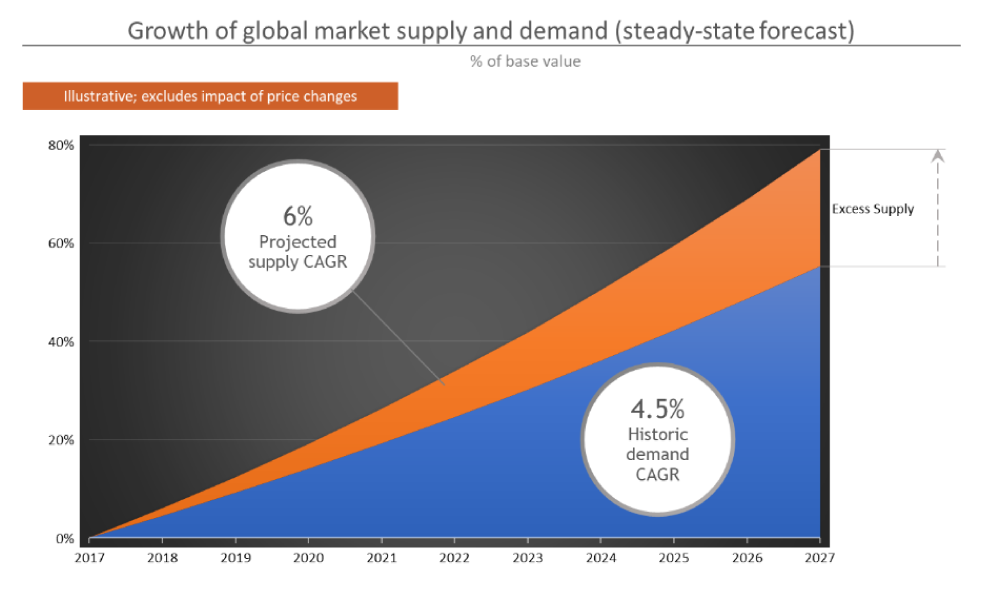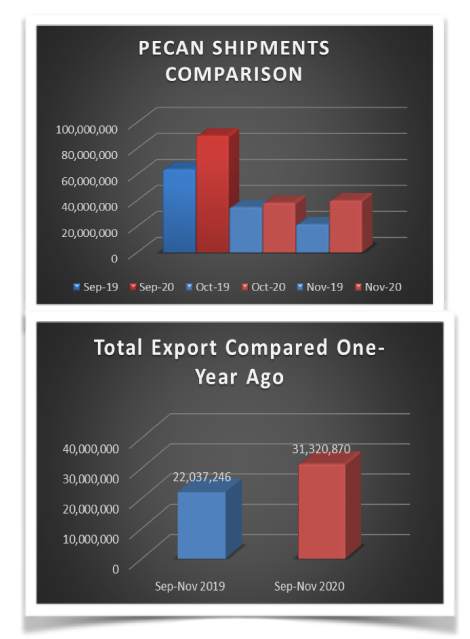In 2016, the American Pecan industry approved a Federal Marketing Order (FMO). The purpose of the marketing order was to implement five critical areas. These included: Marketing/Promotion; Research; Grades & Standards; Data & Statistics; and Compliance.
The American Pecan Council (APC) does not and cannot do the following: set prices; buy/sell product; or set tariffs.
Unfortunately, there are several in the industry that have a misperception that the APC sets prices or oversees adjusting the price. This is not true. The APC has the ability to increase awareness, assist in educating the consumers about pecans and their health benefits and drive consumption. In short, the APC focuses on “pull marketing” activities, which essentially means we drive consumers to “pull” pecans off the shelf.
Early Data Supports the Need of an FMO
In a study conducted by the APC in its early months, data proved how vital it was to establish a marketing program for consumers due to the large volume of pecans that were going to hit the market within the next 10 years. Specifically, supply was growing 33% faster than demand under current projections. Additionally, 20% of global demand growth was driven by the Chinese market. In short, if the industry did absolutely nothing for marketing or consumption activities, product would exceed demand by 15% in ten years, and consumption was growing at a negative to stagnant level while other nut categories (almonds, walnut, cashew and pistachio) grew by double digits. The APC had to put pecans on the map and fast.
Marketing and Data Collection
After approving a strategic plan for the industry, the APC went to work to increase “pull” marketing activities, consumer awareness and consumption as well as focus on fighting for its fair share in the marketplace. Partners helping the industry include Weber Shandwick, Digital Magnet/I-Heart Radio, Learfield, Eat Well Global, Health Researchers, social influencers and Chefs Summit to name a few. In fact, the APC utilizes over 70% of its budget for consumer activities. It needs to be emphasized that these activities are aimed at our target audience and seek to drive consumers to “pull” pecans off the shelf, not for growers and handlers—who are already avid pecan lovers—to pull product off the shelf. While we’d love industry members to be intercepted with our advertisements as they go about their lives, it’s not a bad thing that that’s not the case. The APC bears the responsibility of being a wise and informed steward of industry funds. We are fully committed to making the highest impact with limited resources, so we rely on data to inform who, when and how we target those who have a greater potential to move the needle. Consumers in top markets did not understand what a pecan was. APC activities have helped consumers understand more about the health benefits of the product and, through recipe development, have showed consumers how to use pecans in snacking, baking and everyday occasions. Until the APC, there were no widespread materials for consumers to understand the versatile pecan.
Thanks to advertising via radio, social media, TV and earned media (free advertising), awareness of pecans has shot through the roof. In 2016-2017 when the APC first began, only 12% of consumers knew what a pecan was or bought pecans. Today, that number is over 30% and growing. This is a big success for the industry in getting the word out about pecans.

Shipments
As Share of Voice grows, the next measurement to look at is shipments. Despite the China tariffs, hurricanes, floods, fires and a pandemic (all within 18 months), consumption and shipments grew. How? As consumers become more aware of pecans, the demand grows. The result—despite all the challenges the industry faced—was success. Consumers still want pecans! For example, Chinese tariffs had a dramatic impact on the market. Approximately 1/3 of the U.S. crop was exported to China prior to the tariff imposition. However, when the tariff hit, 80 million pounds of nuts had to find a home. Without marketing activities driving consumers to the store to purchase pecans, shipments would have halted, and consumers would have chosen other products that they already knew. The additional nuts not going to China would have placed more product on the market and conditions could have been worse. The APC continued to drive consumer awareness, making sure consumers knew about the availability and versatility of pecans. Additionally, the APC increased its international marketing efforts in Europe and China, driving consumer awareness. The increased shipments domestically and in exports in 2020 from 2019 show the success the industry is having in these challenging times thanks to the marketing activities of the APC.
Consumption
Another measurement used to measure success is consumption. If awareness and shipments are up, then consumption should also be up. The short answer is yes, it is. Thanks to APC efforts in increasing awareness and shipments, consumption grew, despite the tariffs and pandemic. In 2019, consumption was up 33.5%. In 2020, it was up an additional 14.5%, with a pandemic and loss of food service. In fact, with the heavy social media platform presence that APC was using, consumption went up due to mobile pickups and grocery deliveries.
Rate of Return
The final measurement the industry measures is the Rate of Return on Investment. This is a mandate by USDA for all programs. The study must be conducted by a third party, and all activities and budgets are reviewed and studied to see what type of return, if any, there is for the industry and specifically the grower. In January, the University of Texas A&M completed a review of the FMO and concluded in their executive summary:
“The primary conclusion from the promotion analysis is that, despite its relatively recent launch, the American Pecan Council has effectively enhanced domestic and export demand for U.S. pecans over 2016/17 through 2019/20 through its generic promotion activities and generated a relatively high rate of return to pecan producers who have paid for the promotion over that period. The principal accomplishment of the APC domestic and export promotion program has been to support the annual average producer price of pecans about 24¢/lb (11%) above the level to which it might have fallen over the period of 2016/17 through 2019/20 if the promotion had not been done. Given APC promotion expenditures (including MAP funds but excluding administrative costs), the benefit-cost ratio for the APC promotion program for 2016/17 through 2019/20 is calculated at 9.9, meaning that the promotion returned $9.9 in profit to pecan producers for every dollar spent on promotion.
An important implication of the promotion analysis is that the pecan promotion program is vastly underfunded imposing a huge opportunity cost on pecan producers of potentially millions of dollars. For every dollar in additional assessment NOT paid by pecan producers and thus, not spent on pecan promotion, producers lose an average of $9.9 in additional profit. Of course, increases in checkoff assessment rates and total spending on promotion are usually accompanied by a reduction in the corresponding BCR. But with such a high estimated BCR, producers could profitably afford to increase the assessment rate substantially beyond current levels and still expect to generate a quite reasonable rate of return comparable to the $2 to $6 per dollar of promotion earned by the beef, pork, cotton, soybeans, and other of the larger commodity promotion programs.”
Once published, the full study can be viewed on the APC’s website at americanpecan.com.

Other Activities
It should be noted that there are several other activities that the APC continues to work on other than promotion. Specifically, this includes gathering data that is audited and disseminated amongst the industry. This data is audited if not submitted and provides industry with real, non-survey data.
Additionally, the APC has completed its satellite acreage survey. For the first time, the industry has the total acreage of each state and the age of the trees. This will assist the industry in forecasting and establish a database on crop production.
Furthermore, the APC continues to look at developing a Quality Assurance Program (QAP) that will assist the industry in getting sustainability credit and potential dollars for activities that they are already doing. By utilizing this program, the approved grower or handler may utilize a special seal on their packaging letting consumers know that the pecans meet or exceed the requirements of the QAP. This will assist in telling the story of how pecans get to the market and what type of activities are utilized for growing quality pecans, all while building consumer confidence in the product.
Other activities include: Chef Summits; pecan health research; conversations with health professionals; employing lifestyle and nutrition influencers as pecan advocates; and coordinating the 20+ state, regional and national organizations to share and disseminate information amongst the industry so we save dollars and avoid duplicating efforts.
The FMO Works
In 2016, the industry voted to establish a federal marketing order that would assist the industry in marketing, promoting, researching, compiling data and statistics, and establishing grades and standards for the betterment of pecans. It took 18 months to establish the FMO (hiring the staff, establishing the office and programs, collecting assessments and compliance with the USDA regulations), but once it was in place and operational, activities progressed. The results have been fantastic. In the past three and a half years:
- Awareness is up
- Shipments are up
Consumption is up - Website traffic is up
- Social media engagements are up
- For every $1 invested into the APC by industry, the returned value equates to $9.9
In all key measurements, the FMO has met or exceeded expectations. The industry should be proud of its accomplishments, even with all the challenges thrown at the pecan producers, handlers and accumulators. Despite all the tariffs, floods, hurricanes and the pandemic, the industry is stronger than it was in 2016, and members should be proud of the foundation they have built for themselves and their children.











